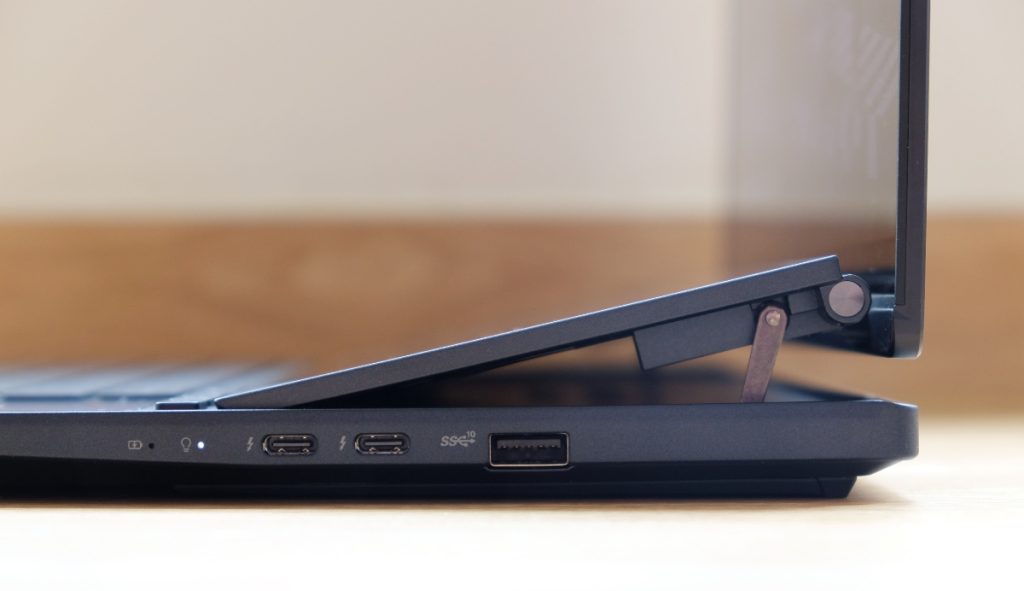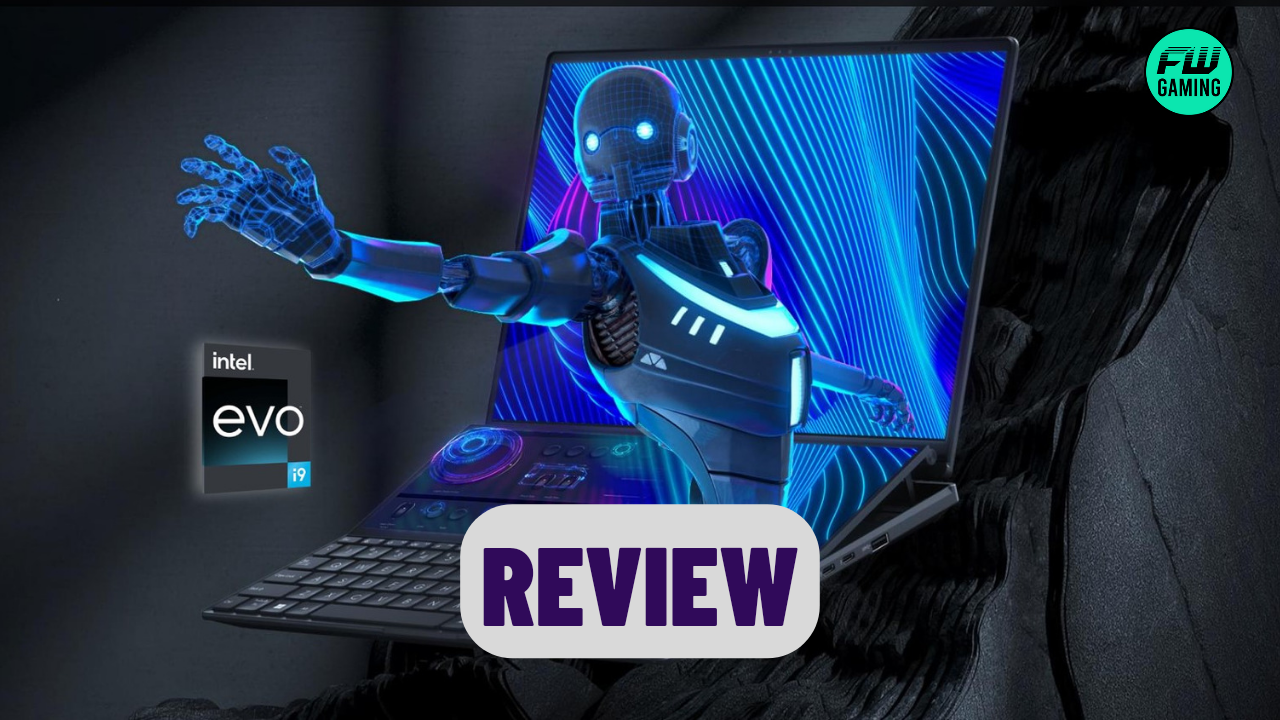The Asus Zenbook Pro Duo 14 OLED was first released in August of last year and was regarded as somewhat of a game-changer in the laptop market, due to its commitment to the integration of a second screen. We were lucky enough to get our hands on the device to see for ourselves what all the hype is about and debate whether the Zenbook Pro Duo 14 OLED is still a good tool for a productive creative to add to their arsenal.
Instead of beating around the bush, let’s just get straight to the point. While we will look at the device’s other components further on in our review, the main selling point of the Zenbook Pro Duo 14 OLED is the display that it comes equipped with. The 14.5-inch 2.8K 120Hz OLED touchscreen is the star of the show, offering a sharp, crisp image display and perfect blacks from any viewing angle.
If that large, stunning display isn’t enough, the Zenbook Pro Duo 14 also comes packing a second 12.7-inch touchscreen which allows for multitasking and even more productivity. This means that social media feeds can be displayed on the bottom screen while you work on a spreadsheet using the top display, (or binge your favorite TV show for the twentieth time.)
Also read: Roccat Torch Microphone Review – This Mic Is Hot!
I often used the bottom screen to keep an eye on my Steam game downloads while playing a game on the top screen. There are also a limited number of games that have actually been optimized to take advantage of this bizarre dual-screen layout, with the inventory menu being displayed on the smaller, lower screen; freeing up the top screen to display the game world in full-screen mode without being hindered by any interruptive UI elements.
As unique and potentially innovative as the inclusion of an inbuilt second screen is within a laptop, it does come with a few trade-offs. Most of these come from the fact that the rest of the device has had to be reconfigured to accommodate that second screen. These adjustments include moving the trackpad to the bottom right corner of the device, rendering the device essentially unusable for any left-handed people.

The trackpad also sits extremely close to the bottom and side edges of the Asus Zenbook Pro Duo 14 OLED, as does the keyboard itself. This unfortunately results in the whole thing feeling cramped and awkward. Also, this overcrowded layout means that it is virtually impossible to pick up the laptop without inadvertently hitting a key or clicking the trackpad when the screen is open.
Although the novelty of that second screen is initially very appealing, I found that it really didn’t last that long. In terms of everyday usage, the average user is only going to utilize that top display, while essentially completely disregarding the bottom display. Eventually, I neglected to even switch the bottom screen on in order to try and save the limited battery that the device provides.
Also read: Why a Spigen Phone Case Is Still the Best Choice for a Foldable Phone
Speaking of which, the limited battery in the Asus Zenbook Pro Duo 14 OLED is another major flaw. On average, I was getting around two hours out of it when continuously playing through a game while unplugged. My mileage did vary slightly depending on the game that was being played. The games that I tested on the Asus Zenbook Pro Duo 14 OLED were; Sunset Overdrive, Hi-Fi Rush, Hypercharge: Unboxed, High On Life, Redfall, Trek To Yomi, and Those Who Remain.
Even when not gaming on the laptop, the battery life drained notably quicker than the 9.5-hour battery life promised by Asus. The reduced battery life is just another example of a compromise that has been made for the sake of including two screens to the detriment of the device’s overall quality, however as previously mentioned the second screen can be switched off to save some battery. Then again, doing this pretty much negates the point of even having a second screen altogether.

With all of that being said though, it should be remembered that that battery is being used to power a pretty significant amount of fairly powerful hardware. The Asus Zenbook Pro Duo 14 OLED runs on an Intel Core i9-12900H processor and the model that we were sent for review also contained a dedicated graphics card. The GPU that Asus chose to go with is the NVIDIA GeForce RTX 3050 Ti and it handled all of the games that I tested pretty well.
Obviously, Redfall was a complete mess, but that cannot be blamed on this device given the sorry state that Xbox decided to release the game in. I did notice a few framerate issues and some input lag in games like Trek to Yomi and High on Life, however nothing game-breaking occurred outside of Redfall.
Also read: Turtle Beach Scout Air True Wireless Earbuds Review
Combine the decent CPU and the fairly meaty graphics card with a 1TB SSD, inbuilt Wi-Fi and Bluetooth, and 32 GB of RAM and it makes up a perfectly capable piece of tech. As great as all of that hardware is and as much as I love the sturdy aluminum shell that contains it, there is one element lacking in terms of build quality and that is the ports.
The Asus Zenbook Pro Duo 14 OLED comes with a 2.1 HDMI port, a MicroSD slot, a headphone/microphone combi-socket, two Thunderbolt 4 slots for connecting to USB-C, and a singular USB-A 3.2 slot. While it is true that more and more tech is moving towards using a USB-C connection over USB-A, the choice to include more USB-C slots than USB-A is baffling.

This means that you cannot have a controller and a mouse connected at the same time without utilizing an external USB hub. If you are looking to also connect an external hard drive, a drawing tablet, a full-sized keyboard, or any other USB-A-connected device then you are going to have a difficult time.
I am not asking for eight more USB-A slots to miraculously be given the real estate on the device’s limited permitted to be added, but one measly USB-A slot is simply not enough. The Asus Zenbook Pro Duo 14 OLED also lacks an Ethernet port, meaning that users have no choice but to rely on the device’s inbuilt Wi-Fi.
Also read: Roccat Pyro Keyboard Review – A Kickass Keyboard That Is Almost Flawless
Overall, the Asus Zenbook Pro Duo 14 OLED is an undoubtedly well-made laptop. It provides a premium feel in terms of its quality and its ability to handle almost anything thrown at it is impressive. However, a handful of practical compromises that have been made will lead potential buyers to weigh up whether the trade-off is worth it for the sake of the flashy novelty that the second display provides. Considering the device is almost a year old at the time of writing, it is still a great option for productive multi-taskers to have up their sleeve.
Asus Zenbook Pro Duo 14 OLED laptop – 8/10
The Asus Zenbook Pro Duo 14 OLED laptop was provided to FandomWire for review by Asus.
Follow us for more entertainment coverage on Facebook, Twitter, Instagram, and YouTube.










